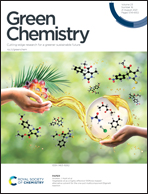High-performance 3D printing UV-curable resins derived from soybean oil and gallic acid†
Abstract
Developing sustainable 3D printing materials has attained intensive interest due to the rapid growth of the 3D printing industry and the concerns on depletion of fossil resources and environmental pollution. In this work, a novel biobased UV-curable oligomer (GMAESO) was firstly synthesized from epoxidized soybean oil (ESO) and gallic acid (GA) via a ‘green’ one pot method. The obtained biobased oligomer possessed a biobased content of 82.9%. By co-photopolymerization of the obtained oligomer with a hydroxyethyl methacrylate (HEMA) diluent, a series of UV-curable materials were prepared, and their properties as well as curing behaviors were investigated. Notably, the resulting GMAESO resins with high HEMA contents (50–60%) showed low viscosities (52–93 mPa s) and excellent thermal and mechanical properties (a Tg of 128–130 °C, Tp >430 °C, a tensile strength of 42.2–44.4 MPa, etc.) which were comparable or superior to a commercial product. Furthermore, the optimal resin (GMAESO with 50% HEMA) was used for digital light processing (DLP) 3D printing. The resin showed lower penetration depth (0.277 mm) than the commercial resin, thus different-structured objects with high resolution were successfully printed. In general, the developed bio-based UV-curable resins are very promising for application in the 3D printing industry.



 Please wait while we load your content...
Please wait while we load your content...